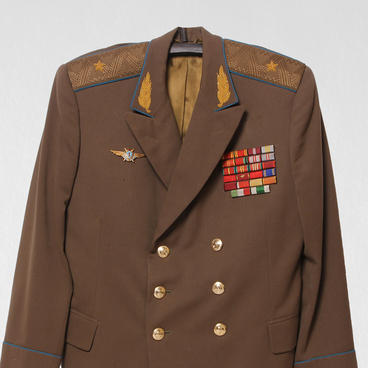The overland route from the European part of Russia to the China borders was called the Siberian Route. When the construction began, the first voluntary settlers went to Siberia. They were eager to find out whether this region was suitable for life. Peasants were also among the travelers.
The late 19th — early 20th centuries’ original costume of a peasant woman displayed at the museum’s collection is sewn of cotton fabric. A long-sleeved ruby chemise, with small pattern of white petals, is fastened with five buttons. A triangles pattern is embroidered on the cuffs with white threads. The neckline has a rounded shape. A high light orange collar covers the neck. The chemise hemline is frilled with a light orange fabric.
A long skirt is the lower part of the costume. The skirt’s uneven coloring, from blue at the top to light blue at the bottom, means that the fabric was painted with natural dyes, which have faded as time went on. The hem is stitched with four blue stripes.
The Siberian peasants preferred factory-made clothing and mill-finished fabrics. An everyday blouse ‘odnoryadka’ (a single-breasted chemise) made of cloth, without collar and lining, cost an average of 4.5 rubles, while the mean annual income of the family made up 77 rubles. However, the Siberian traders did not own high money, and the trade turnover was rather slow, resulting in poor quality textiles that were commonly sent to the region. Thus, people had to sew clothes by themselves very often.
The peasant costume from the museum’s collection is attributed as the everyday wear summer dress. In warm weather, many peasants used to walk barefoot, and wore bast shoes or boots only during haymaking time, in order to protect themselves from a bite from snakes, invisible in the tall grass. Since the peasants’ work clothes were often torn and dirty, so everyone tried to keep a ‘holiday’ outfit for special occasions. They treated it very carefully, as often one such dress served a person all his life, and then it was inherited by children.
The Russian national uniform costume does not exist. Dresses differed in various regions due to the variation in climate conditions, nations’ cultures, and rituals.
The late 19th — early 20th centuries’ original costume of a peasant woman displayed at the museum’s collection is sewn of cotton fabric. A long-sleeved ruby chemise, with small pattern of white petals, is fastened with five buttons. A triangles pattern is embroidered on the cuffs with white threads. The neckline has a rounded shape. A high light orange collar covers the neck. The chemise hemline is frilled with a light orange fabric.
A long skirt is the lower part of the costume. The skirt’s uneven coloring, from blue at the top to light blue at the bottom, means that the fabric was painted with natural dyes, which have faded as time went on. The hem is stitched with four blue stripes.
The Siberian peasants preferred factory-made clothing and mill-finished fabrics. An everyday blouse ‘odnoryadka’ (a single-breasted chemise) made of cloth, without collar and lining, cost an average of 4.5 rubles, while the mean annual income of the family made up 77 rubles. However, the Siberian traders did not own high money, and the trade turnover was rather slow, resulting in poor quality textiles that were commonly sent to the region. Thus, people had to sew clothes by themselves very often.
The peasant costume from the museum’s collection is attributed as the everyday wear summer dress. In warm weather, many peasants used to walk barefoot, and wore bast shoes or boots only during haymaking time, in order to protect themselves from a bite from snakes, invisible in the tall grass. Since the peasants’ work clothes were often torn and dirty, so everyone tried to keep a ‘holiday’ outfit for special occasions. They treated it very carefully, as often one such dress served a person all his life, and then it was inherited by children.
The Russian national uniform costume does not exist. Dresses differed in various regions due to the variation in climate conditions, nations’ cultures, and rituals.



